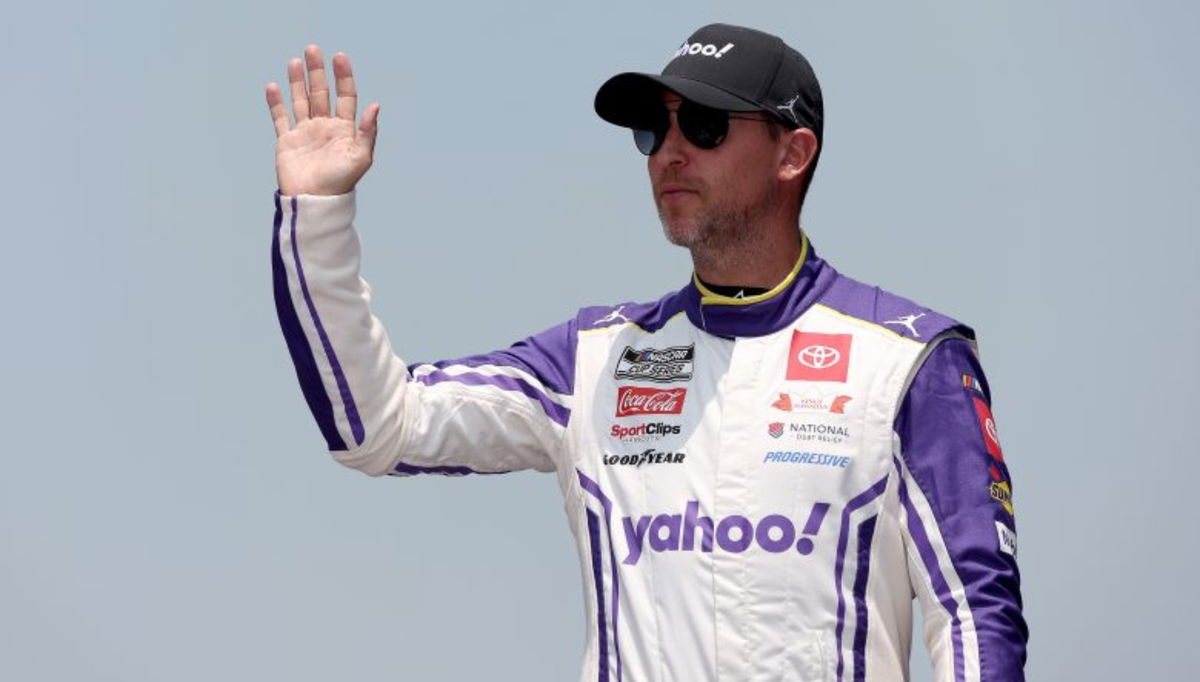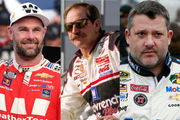
Imago
NASCAR.com

Imago
NASCAR.com
The energy at Dover Motor Speedway was palpable as the clouds parted after a 56-minute red flag halted Sunday’s AutoTrader EchoPark Automotive 400. Denny Hamlin emerged from the pit lane standstill to lead the final 67 laps, fending off Chase Briscoe in back-to-back overtime restarts for his fourth Cup Series victory of 2025.
Watch What’s Trending Now!
This win also makes him only the 7th driver ever to earn multiple wins after his 700th Cup start. It marked Hamlin’s second straight win on the concrete mile and his 58th career triumph, with Joe Gibbs Racing teammates Briscoe (P2) and Ty Gibbs (P5) joining him in the top five. This repeat victory echoed Hamlin’s last Dover success in April 2024, when he captured the Würth 400 after leading 136 laps en route to the checkered flag.
Across that rain-soaked afternoon, all the fans, who were already exhilarated by Hamlin’s surge, were treated to a transparent strategy from NASCAR, who kept teams informed that they’d pause on the pit-road apron while jet dryers cleared the first segment, rather than settle for caution laps and dampened excitement.
ADVERTISEMENT
It’s a fan-first ethos that traces back to the 2012 Daytona 500 rain delay, when Brad Keselowski’s in-car tweet galvanized social media engagement and underscored NASCAR’s willingness to embrace real-time interaction with its audience. But the real heat of the moment came when NASCAR’s call to queue the cars on the apron, rather than limp around under yellow, put the finishing act squarely in drivers’ hands.
Denny Hamlin’s full-throated defense
With 14 laps to go in the Autotrader EchoPark Automotive 400, and after a 56-minute wait, NASCAR threw a curveball. Instead of running caution laps to dry the track, a common move, they parked the cars on the apron off Pit Road while crews tackled a soggy Pit Lane. The payoff? When the green flag dropped, fans got pure racing, not a parade under yellow. It was a bold choice, and Denny Hamlin was all in for it.
ADVERTISEMENT
In his post-race chat with Tim Moore, he said, “They didn’t want to run off caution laps, which is very understandable. I mean, we had fans out here were obviously very enthusiastic. When they saw the sun come out, which I love that enthusiasm from our fan base, they wanted to give them all the racing they could at the end of that race.” That’s Hamlin tipping his hat to NASCAR for keeping the show alive for the crowd.
He didn’t stop there. Hamlin gave props to the transparency too, noting, “And so we knew, and they told us beforehand, before we even got in the cars, that here’s the process we’re going to get in, we’re going to pull out. They need to dry the first half of Pitt road, then we’ll be ready to go. So they were very transparent in all that. And I think they did a good job executing it all.” This wasn’t a spur-of-the-moment call. NASCAR laid it out clear as day, and Hamlin respected the hustle.
ADVERTISEMENT
The result? He fended off teammate Chase Briscoe in a nail-biting finish that had fans buzzing. It’s not just about the win; it’s about giving the people what they came for. NASCAR’s fan-first moves aren’t new. Think back to 2017 when stage racing rolled out, breaking races into segments for more action. Purists grumbled, but the crowds ate it up, and Dover’s decision fits that mold.
Hamlin’s take reflects a driver who gets it: fans drive this sport, and he’s not afraid to say it. His defense of the call wasn’t just a victory lap flex. It was a nod to the balance between competition and entertainment. Speaking of shaking things up, Hamlin’s got more on his mind, like where NASCAR should take its regular-season finale. Let’s shift gears and hear him out. With that decisive endorsement secured, it’s time to pivot from Dover to the next marquee moments on the calendar.
Top Stories
Richard Childress’ Grandson to Be the ‘First Casualty’ of RCR-Kaulig Racing Divorce, Claims Dale Jr.

Dale Jr & JRM’s Cup Dreams in Shambles as NASCAR Charters Break $100M Barrier

When an American Legend Confessed to His Long Kept Promise to Dale Earnhardt That He Still Honors

Dale Earnhardt & Tony Stewart Dethroned as SVG Shatters NASCAR Benchmark to Stand Alone in History

Kyle Larson Declares 7-YO Daughter Audrey’s Talent “Better Than Mine” After Red Bluff Triumph

ADVERTISEMENT
The in-season finale deserves more thrill than Indy can deliver, according to Hamlin
Heading into the In-Season Challenge finale at Indianapolis Motor Speedway, Hamlin, credited with pioneering the bracket idea on his Actions Detrimental podcast, offered a few tweaks for maximum impact. Having seen how track-position games played out at Dover, he insists the finale track should foster side-by-side battles, not processional runs.

Imago
NASCAR, Motorsport, USA Wurth 400 presented by LIQUI MOLY May 4, 2025 Fort Worth, Texas, USA NASCAR Cup Series driver Denny Hamlin 11 is introduced before the start of the Wurth 400 race at Texas Motor Speedway. Fort Worth Texas Motor Speedway Texas USA, EDITORIAL USE ONLY PUBLICATIONxINxGERxSUIxAUTxONLY Copyright: xJeromexMironx 20250504_jpm_an4_M27486
“If I were in charge, it’s just tweaking the tracks,” Hamlin said. “Even in your finale next week, you’re not gonna have a side-by-side battle of your head-to-head guys, just because you’re going to a track that we don’t run side-by-side. It’s just refining your schedule around, if you keep it, make sure you got these five racetracks that could create a compelling thing to watch on TV.” His point: select venues where the Next Gen car’s handling can facilitate close-quarters racing and genuine overtake opportunities.
ADVERTISEMENT
He’s especially wary of the Brickyard, noting, “Even if you have someone who’s, if next week your top two guys are running eighth to tenth, they might as well be a full track apart, like that’s just such a huge buffer on a track like Indy.” As Ty Dillon and Ty Gibbs prepare for the bracket final, fans can expect Hamlin’s blueprint in practice.
An action-packed, unpredictable duel, far from the caution-controlled finishes that leave the grandstands yearning for more. With Dover’s thrilling conclusion in the rearview mirror, NASCAR now turns its focus to translating that momentum into the In-Season Finale, where Hamlin’s insights could shape a truly unmissable showdown.
ADVERTISEMENT
ADVERTISEMENT
ADVERTISEMENT
ADVERTISEMENT

